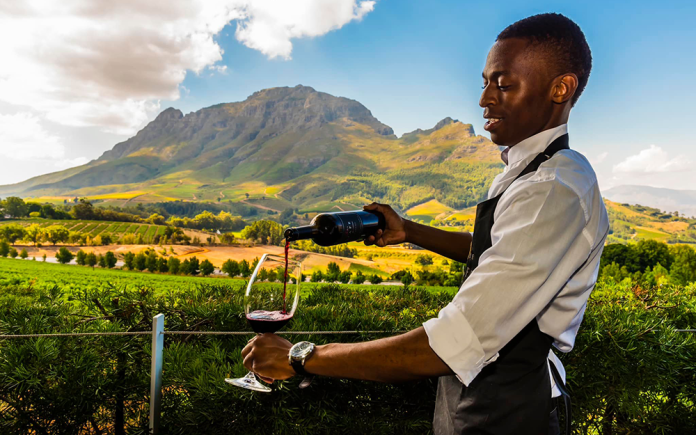
By Rick Riozza
Every so often, we like to re-address the quality of the more than reasonably priced wine from South Africa. We wine enthusiasts who have joyfully experienced the variety of first-class wine at low, and low prices, are actually flummoxed by the lack of interest from this beautiful wine region.
Wine emeritus, Hugh Johnson has stated, “There are many contestants in the world’s vineyard beauty contest, but South Africa is always in the finals. Blue-shadowed stacks of Table Mountain sandstone and decomposed granite rise from vivid green pastures dotted with the brilliant white façades of 300-year-old Cape Dutch homesteads.”
In other words, the expansive scenery is so beautiful, that you just know the wines from these vineyards have to produce some tasty vino!
Grapes were first planted at the Cape of Good Hope (now in South Africa) in the mid-1600s. It provided wine for sailors of the Dutch East India Company on the month’s long voyage from Europe to the highly valued Spice Islands of what is now Indonesia. The Cape was a midway point, just as the style of the Sauv Blanc is midway between Europe and the New World.
The Cape boasts the oldest geology in the wine-growing world: ancient, weathered soils, typically based on either granite, sandstone, or shale, which naturally curtail the vigor of the vine—meaning more intense flavors in the grape. Most South African vines thrive in an almost perfect Mediterranean climate, cooler than their latitudes suggest, thanks to the cold current from Antarctica that washes on the south-west Atlantic coast.
Quite interesting to note: most climatologists predict that of all of the New World wine producers, South Africa is least likely to be seriously affected by climate change. Looks like this region will become more and more known and appreciated in the coming decades. Cheers to that!
Okay now—let’s quickly review some wines that are actually available here in the desert. Though truth be told—you may have to search them out a bit and/or order them from your local wine merchant; and they’ll get them for you, especially if you order a case or two. Stocking up on these well-valued wines is a smart thing, in view of all the price increases we are soon to experience.
So let’s start with a delicious wine that can be found for $15 or less: 2020 Warwick Pinotage Western Cape The First Lady (around $15 or less). Don’t feel at a loss, if you don’t recognize the grape Pinotage. Again, it happens because most of us aren’t geared to appreciate South African wine.
But in South Africa, Pinotage is primarily known for its dark, ripe fruit flavors like blackberry, cherry, and fig, plum sauce, tobacco, blackberry, tar and licorice. It has a bold, sweet jammy flavor with a smoky, earthy finish. It’s the resulting grape of the crossing between Cinsaut and Pinot Noir.
Since Pinotage was such a productive wine grape, producers back in the day (when the grape was first created in the 1920s) often made very low-quality commercial wine with it. Fortunately, in the last 15 years, several producers have banded together and focused on reducing the crop yields and used careful winemaking techniques to manage this unique grape.
So back to the 2020 Warwick Pinotage: The wine is round, with supple tannins and well-knit (meaning it is a well balanced wine). This accessible red offers notes of ripe black and red cherry, violet, dried thyme, anise and smoke. It’s the deal of the day, or week, or month—whatever you wish to call it.
Should you wish to try a more high-end Pinotage, we recommend 2018 Diemersfontein Reserve Collection Pinotage ($30) The Reserve Collection Pinotage is a unique style of dry, age-worthy wine produced in the Western Cape region. The wine has a firm tannin mouthfeel, 14% alcohol and bold red fruit aromas complemented by delicious notes of cherry, blueberry, and roasted nuts.
For those looking for a nice white wine, be aware that the Chenin Blanc grape—traditionally known as “Steen”, is the most planted grape in South Africa. It has traditionally been grown as a blending agent for everyday wines, and even “port”.
(In France, Chenin Blanc is one of the great grapes of the Loire Valley, most particularly in Anjou-Saumur and Touraine. In the latter district the grape is also known locally as Pineau Blanc de la Loire. Probably the best-known Chenin region is Vouvray, which makes wines that will last decades.)
Chenin Blanc and Riesling have much in common, due to their versatility. They can make a wide variety of wines, from bone dry to lusciously sweet, though always with a backbone of balance achieved through cradled, high acids. This means they always taste fresh. Such high acidity also allows them to age, though the wines can also make an extraordinary statement when young.
But Chenin Blanc stands a little apart from Riesling, and that is because of its extraordinary textural quality. Adam Mason, winemaker at Mulderbosch in Stellenbosch, South Africa’s premium wine-growing region, says this component is achieved by picking at slightly lower sugar levels. This practice “enhances the texture of the wine in a mineral, steely way,” he says. However, besides texture, he also values freshness very highly.
The 2021 Fairvalley Chenin Blanc at only $10, is an easy drinking wine that features a creamy mix of poached pear, chamomile, tangerine and spice notes, ending with a juicy finish. What’s not to like here at that price!!
A very high-end Steen for grins and to accompany a great dinner course, is the 2020 David & Nadia Chenin Blanc Swartland Stakkekop ($90). It’s a creamy broad-shouldered white with lively acidity carrying flavors of creamed pear, hazelnut, star fruit and pickled ginger. If you can afford it, have at it! Cheers!











































